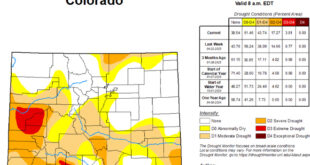Local insects take advantage of mild winter
No matter where you go in the Gunnison Valley right now, some kind of insect is having its day. In some of the aspen and cottonwood trees of the upper valley, the western tent caterpillar is taking over. Down valley, the miller moth has come in droves this year.
“I can safely say our insects have come out more this year than last year and they’ve come out more than on average,” says Eric McPhail, director of the Gunnison Office of Colorado State University Extension. “Some of that’s due to the winter we had. It was a little bit warmer and there weren’t as many cold nights.”
Some insects, he says, such as mosquitoes, prefer the years of heavy rain, while others do best in dry conditions. That, McPhail suspects, is the case for the tent caterpillars, which can be seen squirming around inside their white web houses among the branches of many unfortunate trees.
Mt. Crested Butte resident Kim Spence says he usually sees a few tent caterpillars crawling in the trees starting in May. “I’ve noticed one or two every year,” he says. “This year there were 30 to 40 in neighbors’ trees.”
When a group of young caterpillars arrive in a branch, they can strip it bare of leaves before growing too large and being forced to split up. Then they spread throughout the tree. According to research from Washington State University, a single tent can cost a healthy tree 20 percent of its leaves.
But McPhail says, “Caterpillars won’t kill a tree,” although they could weaken its defenses, making it more susceptible to other ailments, like disease or parasites. “Any tree that experiences stress is prone to disease and insect infestations. That is a concern,” he says. “I think people with trees, especially in their yards and landscaping, need to pay attention to watering this year. But any big shrubs and trees will usually be fine and the caterpillars won’t kill the limb even.”
Since the caterpillars are drawn to deciduous trees, in the Gunnison Valley, they’re attracted to aspen, cottonwood, willow and even the wild roses, although researchers have seen the larvae settle for many other kinds of plants in years of heavy infestation.
The caterpillars will eat and grow for more than a month before settling into a cocoon for a week or more in the final stage of metamorphosis before emerging as an adult moth.
The preferred method of eradicating the caterpillars is to cut the affected branch and burn it. But with Stage Two fire restrictions in place across the county, taking that step could cost you a hefty fine and maybe a lot more.
“Depending on how much rain we get in July, August could be a tough month for the forest trees,” McPhail says.
 The Crested Butte News Serving the Gunnison Valley since 1999
The Crested Butte News Serving the Gunnison Valley since 1999


